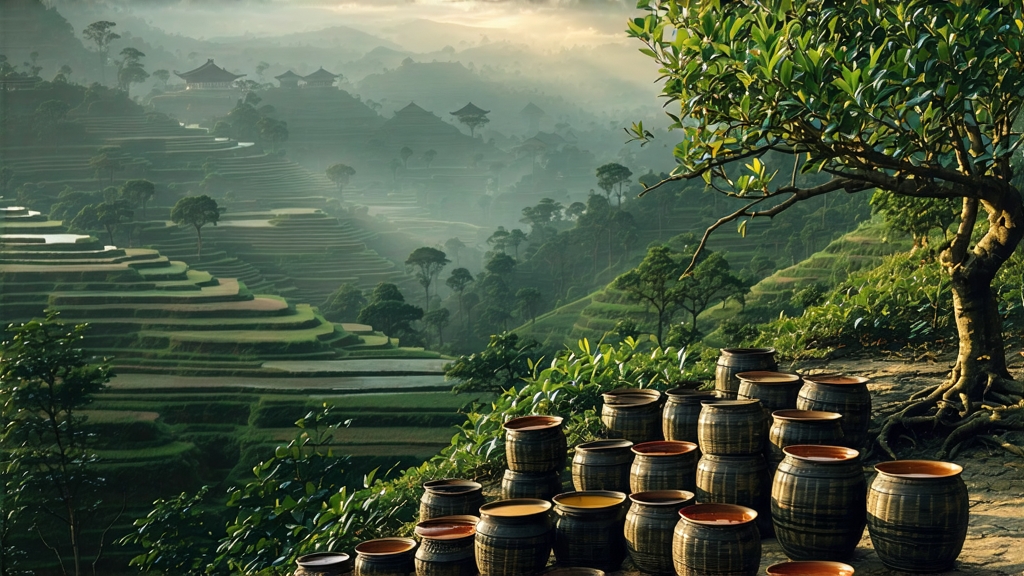
Phoenix Dancong, literally “Single Grove,” is not merely an oolong; it is a living archive of China’s southern tea soul. Nestled in the 1,400-metre granite spires of Phoenix Mountain(Fenghuang Shan)in northern Guangdong, this cultivar family has been whispering its perfumed stories since the Song Dynasty, when imperial tribute officers first carried its leaves northward along the Meiling Pass. Today, connoisseurs from Paris to Melbourne chase the same lingering aftertaste that once graced the cups of Emperor Huizong, yet few outside China realise that “Dancong” is not one tea but hundreds of genetically distinct micro-varietals, each named after the floral or fruity aroma it is believed to mimic—orchid, almond, ginger flower, bitter orange, even ripe mango.
The mountain itself is a vertical mosaic of subtropical forest and terraced gardens. Morning clouds roll up the ravines like slow tides, cooling the leaves and coaxing slow, even growth. The soil is lateritic, rich in iron and eroded quartz; its mineral bite translates directly into the tea’s signature stony finish. Growers still practise the ancient “zhai shan” system: every tree is individually owned, often by a single clan for more than twenty generations. A 300-year-old bush can fetch the price of a Beijing apartment, not for its yield—barely 800 g per spring—but for the irreplaceable complexity of its leaf chemistry.
Processing Phoenix Dancong is a high-wire act between oxidation and fragrance retention. Picking begins at dawn when the leaf’s aromatic esters peak; only two leaves and a bud are plucked from each tip. The first wilting is done outdoors on bamboo trays, where mountain breezes reduce moisture to 68 % within ninety minutes. Indoors, the leaves are alternately shaken and rested for eight hours in a ritual called “qing wei,” the green awakening. Each toss bruises the margins just enough to liberate enzymes that will later create the honeyed orchid note. Oxidation is arrested at 30 %—higher than Tieguanyin, lower than Da Hong Pao—by a 230 °C tumble in a cast-iron wok for exactly four minutes, judged by the crackle sounding like chestnuts. What follows is unique: a low-temperature charcoal roast performed in a squat mud-brick kiln fired by longan wood. The tea master sleeps beside the kiln for six nights, turning the leaves every forty minutes so that the roast penetrates but never masks the innate bouquet. The final moisture target is 4.2 %, low enough for decades of aging yet high enough to keep the inner oils alive.
Unlike many oolongs that flatten after eighteen months, well-roasted Dancong softens and deepens, developing rum-like sweetness and a camphor coolness reminiscent of aged sheng pu-erh. Connoisseurs in Chaozhou city store small batches in double-lidded clay jars buried in sand to buffer humidity, opening them only on the first full moon of autumn to taste the evolving soul.
To brew Phoenix Dancong gongfu style, begin with a 120 ml white porcelain gaiwan; its neutral glaze will not steal the aromatics. Pre-heat with 95 °C water, then fill one-third with 5 g of long, wiry leaves. The first three infusions are flash steeps—literally three seconds—poured in a continuous circular motion to coax the surface oils. Liquor colour should be not amber but “apricot skin,” a glowing orange-pink that catches the light like a back-lit gemstone. Raise the cup to your nose: top notes of night-blooming orchid and dried longan should appear before you even sip. On the palate, expect a three-act structure: initial bright acidity reminiscent of blood orange, a mid-palate expansion of wild honey and baked almond, and a mineral finish that Chinese tasters call “shan yun,” the echo of mountain stone. The seventh infusion often surprises with a cooling menthol lift, proof that the leaf’s internal labyrinth of terpenes is still unwinding. By the twelfth infusion, lengthen the steep to two minutes; the tea will surrender a gentle grain sweetness, like the memory of fresh sugarcane.
Professional cupping follows a stricter choreography. Leaves are weighed to 3 g, infused for five minutes in boiling water, then